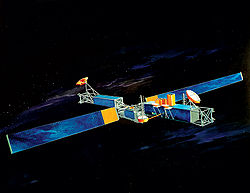Renewable Energy/Solar Photovoltaic (PV)
Introduction
[edit | edit source]Solar Photovoltaic cells convert sunlight directly into electricity. The name "Photovoltaic" comes from the process of converting photons (lights) to voltage (electricity), hence the name photovoltaic. This process is called PV effect. This process was first noted by a French physicist, Edmund Bequerel, in 1839, who found that certain materials would produce small amounts of electric current when exposed to light. This was later expanded by Albert Einstein who mathematically described photoelectric effect on which photovoltaic technology is based. The first photovoltaic module was built by Bell Laboratories in 1954 and its serious use began in the 1960s through space programs. Today, this technology is used to power not only calculators, watches, and entire homes but also space satellites and the Mars rovers.


How it works
[edit | edit source]Solar cells are made out of silicon or other semiconductor materials also used in the microelectronics industry. Electrons are released from the atoms in the semiconductor material when light hits the solar cell. When the photon is re-absorbed by photovoltaic material it knocks an electron away from it's parent atom resulting in a change in charge on the atom. This void is filled by a new electron in order to balance the atom's valence returning it to it's more stable configuration. In an electrical circuit, where the electrical conductors are attached to the positive and negative sides, the electrons can be captured as electricity which can then be used.

The following photovoltaic materials are currently used both terrestrially and on satellites and spacecraft:
- Crystaline Silicon
- May be monocrystaline or polycrystaline in nature. c-Si
- Cadmium telluride
- Cadmium telluride (CdTe) is a crystalline substance generated in a reaction involving cadmium and tellurium. It is both a solar cell material and used as an infrared optical window. It is often layered with cadmium sulfide to make a photovoltaic solar cell that takes advantage of the p-n junction which the two materials form at the interface.
- Amorphous Silicon
- a-Si has been used as a photovoltaic solar cell material for devices which require very little power, such as pocket calculators, improvements in a-Si construction techniques have made them more attractive for large-area solar cell use as well. Here their lower inherent efficiency is made up, at least partially, by their thinness - higher efficiencies can be reached by stacking several thin-film cells on top of each other, each one tuned to work well at a specific frequency of light. This approach is not applicable to c-Si cells.
- Copper Indium Gallium Selenide
- (CIGS) is a semiconductor material which is a solid solution of copper indium selenide (often abbreviated "CIS") and copper gallium selenide.
- Microcrystalline and Micromorphous Silicon
- Microcrystalline silicon (known also as nanocrystalline silicon) is amorphous silicon it however contains small crystals thus absorbing a broader spectrum of light whilst adding structural flexibility.
- Organic photovoltaic cell
- OPVC use organic electronics--which deals with conductive organic polymers or small organic molecules to absorb light transport charge. The optical absorption capability of organic molecules is quite high, so a large number of photons can be absorbed with a small amount of material. OPVC are lower in efficiency, stability and strength when compared to their inorganic equivalents.
- A dye-sensitized solar cell
- DSSC is a low-cost thin film solar cell. It is a semiconducting material formed when a photo-sensitized anode and an electrolyte, a photoelectrochemical system are combined.

Advantages vs Disadvantages
[edit | edit source]The most obvious advantage is that solar energy is very plentiful and will never run out unlike fossil fuels. The 89,000 TW of sunlight reaching the Earth is about 6000 times more than 15 TW, the average power consumed by humans. It also has the highest power density among renewable energies. It is pollution free during use and once installed, it does not require any maintenance for several years so operating costs are extremely low after the initial set up. However, while it is pollution free during use, it does provide some pollution to manage end-wastes. However, this is nothing compared to the pollution caused by traditional means of generating power and can be managed through existing pollution controls and recycling. The obvious disadvantage to solar energy is that energy can only be produced during the day and its production can be drastically effected depending on weather conditions (cloudy, raining). While it is possible to store excess energy in the day and use it during the night, converting DC current to AC current does result in some energy loss.
Future
[edit | edit source]As many of our primary resources such as coal and oil used for energy are non-sustainable and disappearing fast, renewable energy is an attractive option that will grow as non-renewable energies become more and more scarce and renewable energy technology becomes more and more efficient and cheaper. Only a fraction of money invested in nuclear power is invested in solar panel so with more investment and time, there is definitely a big room for improvement. Considering there is about 6000 more times energy than our current consumption free to harvest, even if we can just get a tiny fraction of that energy, it will reduce our hunger for energy significantly
References
[edit | edit source]- United States. US Department of Energy. Solar Photovoltaic Technology. Web. <http://www.nrel.gov/learning/re_photovoltaics.html>.
- United States. NASA. How do Photovoltaics Work. Web. <http://science.nasa.gov/science-news/science-at-nasa/2002/solarcells/>.
